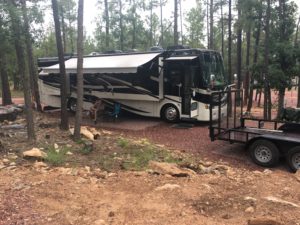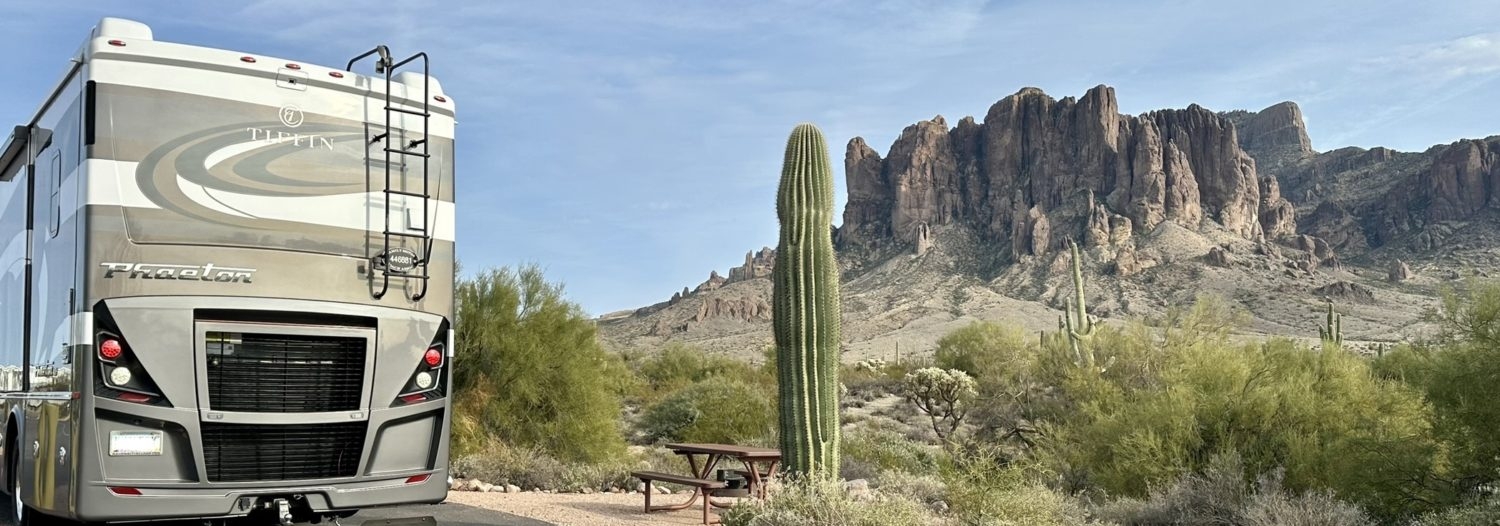TPMS, that’s sexy talk.
But seriously, there is nothing sexy about a blown tire. They always happen at the most inopportune time and for us, in the middle of nowhere. Like 100 miles east of Denver on Interstate 70 middle of nowhere. Thankfully, blow outs were only an occasional happening.
Our first blowout was on Interstate 10 driving to camp in Blythe at the Colorado River for some water skiing fun. It was about milepost 55 going west on I-10. Man, that boom as loud and the back of the RV filled with smoke. Well, we thought it was smoke. It was just air and tiny bits of tire that were wafting through the hole in bedroom floor of our old 1994 29-foot Class C. Yes, you read that right, there was a 12″ x 6″ sort of rectangle hole in the floor of the bedroom along with a fairly good sized piece of tread laying near the bed. Thankfully we were close to the rest stop where we carefully limped in then changed the tire before continuing on our way. Lucky for us there was no other damage. The campground was grass and it was quite funny to look at the grass through the hole while standing in the bedroom.
Class C tires aren’t cheap by any means but they certainly are compared to Class A tires. We couldn’t have blow-outs in our new to us Phaeton. That is money we didn’t want to have to spend so Mark went to the Tiffin forum for help on a good TPMS system. The guys on the forum are great at answering questions on just about any topic.
 He decided to buy the EEZTire Pressure Monitoring System with 6 sensors. Since we tow a Jeep, boat trailer or flat trailer depending on our activity, we decided not to purchase the sensors for all of those tires right now. If we were full-timing and only towing the Jeep, we would have gotten the sensors for it as well.
He decided to buy the EEZTire Pressure Monitoring System with 6 sensors. Since we tow a Jeep, boat trailer or flat trailer depending on our activity, we decided not to purchase the sensors for all of those tires right now. If we were full-timing and only towing the Jeep, we would have gotten the sensors for it as well.

Mark mounted it to the driver’s side window just above the dash line so it’s easy to see at a quick glance without taking your eyes off the road too long.

The system uses sensors that you put on the valve stem of each tire then screw the valve stem cover over the top. Each sensor sends the tire pressure to the main unit. The screen on the main unit cycles through each tire for the entire trip letting you know how much tire pressure is in each tire. Using this system you can spot a tire failure or a leak long before it actually explodes. At least that’s the theory and knock on wood, so far so good.
Mark did buy spare sensor batteries that we keep in the RV as they don’t last forever. They take about 20 seconds to replace from start to finish. You could make it a NASCAR event by timing each other.
I have to say that having the TPMS has reduced the worry not only about a blowout but also on the cost of replacing a tire due to a blowout. And doesn’t that make the RV lifestyle even better?


I’m going through the ‘tire thing’ now. I bought the EEZ TMPS prior to our last road trip. Love it, but had to learn to pay close attention to it. Stopped at a Love’s Truck Stop in California and had a tire brought up to better pressure. I didn’t check on the sensors before I left and when I did, one was gone,…………went back on return trip but it wasn’t there. $50.00 to replace. Lesson number one. THEN, on a later short trip, I noticed one sensor did not read anything, it was blank on inside left rear tire, thought the sensor might be bad. WRONG,…when I got around to fixing, I found out the sensor batteries were good, and that my inside tire valve was bad. Lost all tire pressure and having to replace both tires,…$$$$$$ I think I drove around a hundred miles on, effectively one tire. So I need to replace both tires, the load on a single dual tire, I belive is called running flat or something related to the situation. Replacing both tires just to be safe.
Pay attention to your TPMS!!!!!
Yowza! Glad you’re okay.